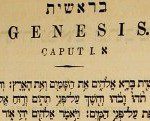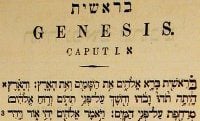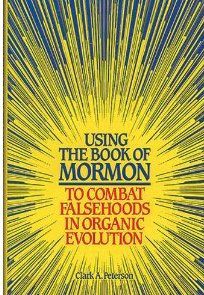
You might have noticed an op-ed on Mormonism and evolution in the Salt Lake Tribune by me, responding to discussion of the place of evolution in Utah science standards. I’m a historian of religion/science with some scientific training, not a scientist, so I generally leave detailed argument and refinement to the actual scientists.
But history can tell us a lot here. I’m convinced that evolution and faith in God can coexist. The short version is, Mormonism has no official position on evolution, BYU unapologetically teaches human evolution, but no one has (yet) offered a good way of squaring this with scripture. Watch this space 😉
Below are some things that have been useful to me, that I hope are useful to you as we get into the first chapters of Genesis on the next few weeks. Also a reminder to check in on Wednesday, when I’ll have a post up in concert with my LDSPerspectives podcast on what’s going on in Genesis 1. If you’re looking for a shortcut, I’ve bolded a few resources. Just go for those.
First, the church has published two statements recently on both dinosaurs (“did dinosaurs live and die on this earth long before man came along? There have been no revelations on this question, and the scientific information says yes.”) and evolution (“The Church has no official position on the theory of evolution. Organic evolution, or changes to species’ inherited traits over time, is a matter for scientific study. Nothing has been revealed concerning evolution.”) This represents an improvement, in some ways, over the past, but is implementing the statement of the First Presidency in 1910, “That which is demonstrated, we accept with joy.”
Today, the timeline of the earth’s history, where God’s creations fit in it, and how they relate to each other (as well as our contextual understanding of Genesis) is far far more “demonstrated,” established, and understood than it was in 1910. It’s a complicated subject, however, and there is lots of misinformation out there, and intrudes into many other fields, rightly or wrongly. Indeed, what many religious “critics of evolution are responding to is as much the moral package that they (mistakenly) believe is intrinsic to evolutionary theory as the theory itself.” (From Peter Harrison’s essay in Evolution and the Fall, below.)
What’s the history of evolution in Mormonism, and how do Mormons make sense of the scientific data?
- I cited a 1910 statement by the First Presidency above, but you can buy a collection of all the relevant statements in Mormonism and Evolution: The Authoritative LDS Statements. Or you can look them all up online. If you know what they are, and have the time to google.
- Similarly, you can read the 1990 Encyclopedia of Mormonism article on evolution (ghost-written by President Hinckley) and the official BYU evolution packet which mostly reprints previous statements (explanation here from The Daily Universe)
- A MormonMatters podcast with current and past biology professors Peck, Jeffrey, as well as James McLachlan, who has also done some work in this area. This covers LDS history, mostly, not science.
- Steven Peck, Evolving Faith: Wanderings of a Mormon Biologist . A dozen reviews are collected and linked on the MI Page for the book.
- Peck gave the 2016 Summarhays Lecture at BYU talking about evolution and Mormonism (on YouTube), which was recently published as the lead article in BYU’s magazine out of the College of Physical and Mathematical Sciences. It’s not available online yet.
- The collection The Search for Harmony: Essays on Science and Mormonism has some great historical essays, and is available entirely online.
- Evolution and Mormonism: A Quest for Understanding, by two LDS scientists.
- LDS geneticist Ugo Perego spoke about “What does the Church believe about Evolution?” at this years FAIRMormon Conference, but the transcript is not yet available.
- I addressed evolution and LDS history briefly in my FAIR Conference presentation, Truth, Scripture, and Interpretation: Some Precursors to Reading Genesis
- This LDS blog by a science PhD (he likes to keep his identity private, but I know him) has some good history and thoughts.
- There’s some relevant material in Mormon Scientist: The Life and Faith of Henry Eyring
- The new volume by Thomas Simpson, American Universities and the Birth of Modern Mormonism has about 50 pages of history on Mormonism and evolution. It’s a great book.
- My two posts on President McKay and Evolution (Post 1, Post 2)
- The backstory to Elder Eyring’s comment about the age of the earth in a recent General Conference.
- I actually have more posts about this, but don’t want to overwhelm.
What about Genesis?
In my view, Genesis doesn’t mean (for evolution or human origins, anyway) what many have traditionally thought. “What it means” is an interpretive question, one that involves conscious and unconscious choices and assumptions. The most important, frequent, and flawed assumption is concordism; that is, that revelation in Genesis and science must be in concord. But this assumes that Genesis and revelation must inherently be of a scientific nature, even if in veiled or metaphorical language.
I can’t recommend much by way of LDS analysis of Genesis and origins, because they all make concordist assumptions, never evaluate or question that assumption.
Another claim I’ve seen is that divine scripture/revelation somehow doesn’t require human interpretation, that its meaning is clear and evident, whereas science is a human endeavor that *does* require human reasoning. The problem here is that you cannot simply “believe the word of God” without an implicit claim to an understanding of what it says, and that requires interpretation, which is a human process. Even Joseph Smith, after getting revelation, had to try to understand it… which is interpretation.
D&C 130:14-16 I was once praying very earnestly to know the time of the coming of the Son of Man, when I heard a voice repeat the following: Joseph, my son, if thou livest until thou art eighty-five years old, thou shalt see the face of the Son of Man; therefore alet this suffice, and trouble me no more on this matter. I was left thus, without being able to decide whether this coming referred to the beginning of the millennium or to some previous appearing, or whether I should die and thus see his face.
So rhetoric that overplays a contrast between the completely divine “inspired word of god” and completely human “philosophies of men” ignores how the “revealed word of God” must be interpreted and understood by humans, even inspired ones. I’ve often encountered people strongly opposed to evolution, who have read some science, but never even considered or read anything on the interpretive side by good scholars. So how should we approach Genesis and interpret it? I tackle this question in my FAIRMormon presentation linked above. And below are some excellent works looking at Genesis in this light.
- Evolution and the Fall has some excellent essays on the implications of evolution for scripture. My favorites are the introduction, and the essays from Peter Harrison (eminent historian of science), James K.A. Smith of How Not to Be Secular and MI Podcast fame, and J. Richard Middleton with some fantastic observations on Genesis 2-3. (He wrote a great book on the image of God in Genesis 1:26-27) I really wish this collected volume had come out few years ago. More here.
- Genesis 1-2: An Evangelical Conversation or a shorter same kind of thing, The Early Chapters of Genesis: History, Fiction or Neither? Each has multiple authors, of the format wherein each presents his own view, with short responses from the other authors.
- John Walton’s books The Lost World of Genesis 1: Ancient Cosmology and the Origins Debate (which I reviewed here) and Adam and Eve: Genesis 2-3 and the Human Origins Debate.
- Peter Enns, The Evolution of Adam: What the Bible does and doesn’t say about Human Origins Enns is one of my favorite scholars, and I recommend all his books. Some are written to be more popular/accessible than others, but all are readable.
- How I changed my mind about Evolution: Evangelicals Reflect on Faith and Science– These are less academic essays and more personal reflections. Not every author here came from the same starting point with regards to evolution nor the same field of professional training. They include biblical scholars like N.T. Wright and Tremper Longman (author of two books on Genesis), scientists like geneticist Dennis Venema and Francis Collins, who headed the National Institute of Health and the Human Genome Project, and James K.A. Smith (above.) More here.
- Daniel Harlow, “After Adam: Reading Genesis in an Age of Evolutionary Science” (PDF) Harlow mixes science with interpretation of Genesis, and it’s the latter that I find so useful.
- Reading Genesis after Darwin (Oxford Press). As it turns out, Darwin/evolution don’t play a huge role in how we interpret Genesis per se. (Obviously it plays a role in biological origins.) This has some excellent essays.
- And my old series at Times&Seasons on Genesis. (Go down to the Institute Week X section)
Science and History
- Peter Bowler, Evolution: the History of an Idea Bowler is a historian of science, often focused on evolution, genetics, etc.
- Larson, Darwin’s Ghosts: the Secret History of Evolution. The idea of evolution, change between species, was around long before Darwin. This is very accessible.
- Ronald Numbers, The Creationists: From Scientific Creationism to Intelligent Design Numbers is the historian par excellence in this area, and has numerous relevant publications on creationism, history of science and religion, as well as Seventh-day Adventism (his own religious background). The history in this book is that “scientific creationism” is actually a fairly recent interpretation of Genesis. I discussed it a bit here at Religion&Politics with a follow-up here.
- Edward Larson, Evolution: The Remarkable History of a Scientific Theory. Larson is a Christian with a JD from Harvard and a PhD in History of Science, under Ronald Numbers. His book on the Scopes Trial won a Pulitzer.
- Adam and the Genome: Reading Scripture after Genetic Science, coauthored by a biblical scholar and a geneticist. More here.
- For some deeper background, Hampton, Storm of Words: Science, Religion, and Evolution in the Civil War Era; Livingstone, Darwin’s Forgotten Defenders: The Encounter Between Evangelical Theology and Evolutionary Thought
- Karl Giberson, Saving Darwin: How to Be a Christian and Believe in Evolution
For some purely online, non-LDS resources, I highly recommend Biologos. Their writers tend to be academics with relevant PhDs, including some name from above like NTWright, John Walton, Peter Enns, and others. For example, I highly recommend this series by eminent Evangelical historian-of-religion Mark Noll.
And if you like listening, The Great Courses offers several excellent series. These are also available through Audible (where you can subscribe and get access to all of them or purchase individually), but there’s more data on each course at TheGreatCourses website, including a list of the lectures. They also come with a 200-page summary of the series.
- Edward Larson (of Pulitzer fame, above) The Theory of Evolution: a history of Controversy (more about reception and culture than science)
- Gregory, The Darwinian Revolution (more about the science)
- Gregory also offers History of Science: 1700-1900
- Kors, Birth of the Modern Mind: the Intellectual History of the 17th and 18th Centuries.
- Goldman, Science Wars: What Scientists Know and How They Know It
- Lawrence Principe, on Science and Religion
- Principe also does History of Science:Antiquity to 1700
- Rendsburg, Book of Genesis. I like his material, but he his presentation style rubs many people the wrong way.
Well, that’s a lot of material. The takeaway points:
- Belief in deity and acceptance of human biological evolution are compatible, though there are questions to be worked out.
- Mormonism and evolution are compatible, though little work has been done explaining why, in essence, if evolution is true, scripture and prophets haven’t always known that. But that’s because we haven’t explored our assumptions about revelation, prophets, scripture, or developed a tradition of interpretation. Addressing this issue is one of my major thrusts, and I have lots on it. Again, watch this space for updates on my book on Genesis 1, my papers, presentations, etc.
- The early chapters of Genesis have much less to say about human origins than it appears to us, today, in English translation, a different culture and worldview, formed post-Enlightenment, post-Scientific Revolution, with very different theological questions and crises than the Israelites had.
- This stuff is fun. And interesting. I love it.
If you don’t see something that appeals, or you have a question that hasn’t seemed
As always, you can help me pay my tuition here. You can also get updates by email whenever a post goes up (subscription box on the right). If you friend me on Facebook, please drop me a note telling me you’re a reader. I tend not to accept friend requests from people I’m not acquainted with.



 Elder Eyring told a story in
Elder Eyring told a story in 











